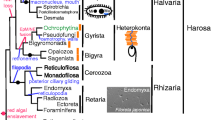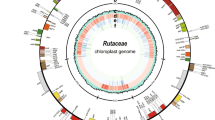Summary
When only plastidic features are considered, it is difficult to distinguish between monophyletic and polyphyletic xenogenous origins of plastids. We suggest that a direct comparison of nuclear and plastidic sequence-similarity pattern will help to solve this problem. The D1 amino acid sequence of six major groups of photosynthetic eukaryotes and of the two groups of photosynthetic prokaryotes are now available, including the psbA-gene product from Bumilleriopsis filiformis, which is the first molecular sequence reported for a xanthophycean alga. Evidence is provided for an independent and polyphyletic origin of plastids from five out of the six major taxa of photosynthetic eukaryotes. This conclusion is reached by comparing a plastid-based pattern of D1 similarity with a nucleus-based similarity pattern published recently. Furthermore, the availability of D1 sequences from five eukaryotic algae led to a re-evaluation of the taxonomic position of Prochlorothrix.
Similar content being viewed by others
References
Böger P, Sandmann G, Miller R (1981) Photosynth Res 2:61–74
Boyer SK, Mullet JE (1988) Nucleic Acids Res 16:8184
Cavalier-Smith T (1981) BioSystems 14:461–481
Cavalier-Smith T (1982) Biol J Linn Soc 17:289–306
Cavalier-Smith T (1987) Ann NY Acad Sci 503:55–71
Curtis SE, Haselkorn R (1984) Plant Mol Biol 3:249–258
Erickson JM, Rahire M, Rochaix JD (1984) EMBO J 3:2753–2762
Felsenstein J (1983) Annu Rev Ecol Syst 14:313–333
Felsenstein J (1988) Annu Rev Gen 22:521–565
Fitch WM, Margoliash E (1967) Science 155:279–284
Gingerich J, Buzby JS, Stirewalt VL, Bryant DA (1988) Photosynth Res 16:83–99
Giovanni SJ, Turner S, Olson GJ, Barns S, Lane DJ, Pace NR (1988) J Bacteriol 170:3584–3592
Golden SS, Brusslan J, Haselkorn R (1986) EMBO J 5:2789–2798
Gray MW (1989) Trends Gen 5:194–199
Gray MW, Doolittle WF (1982) Microbiol Rev 46:1–42
Hirschberg J, McIntosh L (1983) Science 222:1346–1349
Janssen I, Jakowitsch J, Michalowski CB, Bohnert HJ, Löffelhardt W (1989) Curr Genet 15:335–340
Karabin GD, Farley M, Hallick RB (1984) Nucleic Acids Res 12:5801–5812
Kostrzewa M, Valentin K, Maid U, Radetzky R, Zetsche K (1990) Curr Genet 18:465–469
Kowallik K (1989) In: Gree JC, Leadbeater BSC, Diver WL (eds) The Chromophyte algae: problems and perspectives. Clarendon Press, Oxford, pp 101–124
Maid U, Valentin K, Zetsche K (1990) Curr Genet 17:255–259
Margulis L (1981) Symbiosis in cell evolution. W H Freeman & Co, New York
Maxwell ES, Liu J, Shively JM (1986) J Mol Evol 23:300–304
Morden CW, Golden SS (1989 a) Nature 337:382–385
Morden CW, Golden SS (1989 b) Nature 339:400 (Corrigendum)
Mulligan B, Schultes N, Chen L, Bogorad L (1984) Proc Natl Acad Sci USA 81:2693–2697
Ohyama K (1986) Nature 322:572–574
Perasso R, Baroin A, Qu LH, Bachellerie JP, Adoutte A (1989) Nature 339:142–144
Raven PH (1970) Science 169:641–646
Reith M, Cattolico RA (1986) Proc Natl Acad Sci USA 83:8599–8603
Scherer S (1989) Mol Biol Evol 6:436–441
Scherer S (1990) Evol Biol 24:83–106
Scherer S, Binder H, Sontag C (1985) Endocyt Cell Res 2:1–14
Schönfeld M, Yaacoby T, Ben-Yehuda A, Rubin B, Hirschberg J (1987) Z Naturforsch 42c:779–782
Sogin ML, Gunderson JH, Ellwood HJ, Alonso RA, Peattle DA (1989) Science 243:75–77
Turner S, Burger-Wiersma T, Giovannoni SJ, Mur LR, Pace NR (1989) Nature 337:380–382
Valentin K, Zetsche K (1990a) Curr Genet 18:199–202
Valentin K, Zetsche K (1990b) Mol Gen Genet 222:425–430
Whatley JM, Whatley FR (1981) New Phytol 87:233–247
Wilhelm C (1988) Bot Acta 101:14–17
Zurawski G, Bohnert HJ, Whitfeld PR, Bottomley W (1990) Proc Natl Acad Sci USA 79:7699–7703
Author information
Authors and Affiliations
Additional information
Communicated by K. Esser
Rights and permissions
About this article
Cite this article
Scherer, S., Herrmann, G., Hirschberg, J. et al. Evidence for multiple xenogenous origins of plastids: comparison of psbA-genes with a xanthophyte sequence. Curr Genet 19, 503–507 (1991). https://doi.org/10.1007/BF00312743
Received:
Accepted:
Issue Date:
DOI: https://doi.org/10.1007/BF00312743




